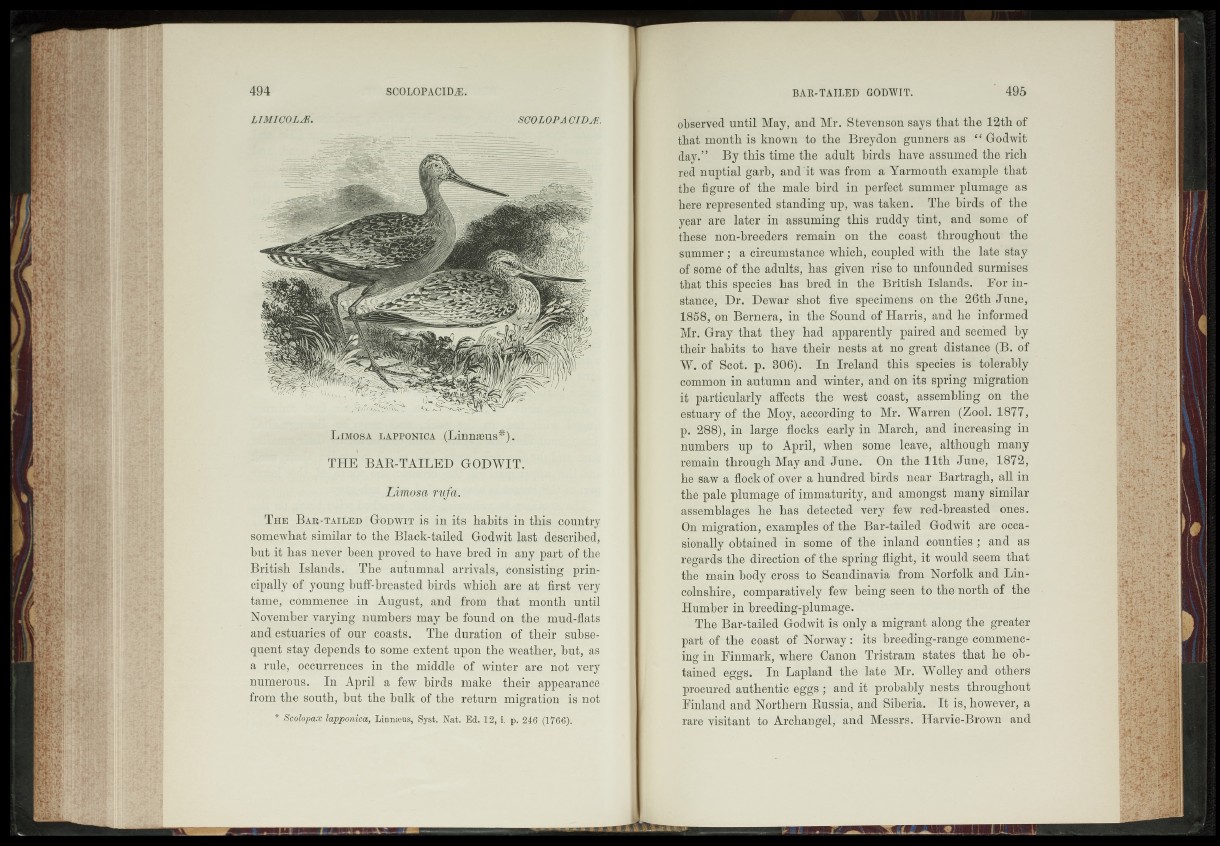
LIM1C0L2E. SCOL OP A ClDJf. observed until 'May, and Mr. Stevenson says th a t the 12th of
LfMOSA pQAPPONtOA .(LiBBSeuS^ky:^
THE BAR- TAILEfly G OD WIT.
- lArhom- ruf^. S
The Bar-tailed . Godwit is rin, if s habits in this country
somewhat similar to the Black-tailed GodwitJMfe described,
hut it has never '&§eji .proved to h av e red in any part-o^bie
British Islands.|A|lfhe autumnal arrivals, Consisting principally
of young buff-breasted bjfcdsr whiqh are-at first j ^ y
tame/commence, An August, and from that Jmpn-th --until
Noxemhor varying.- numbers may be found on,Abel mud-fl,afs
and estuaries gf our coasts/' The duration ,of their subsequent
stay depends to some extent ppgn tha wea tl^ p bu|;';a.s
a rule,* occurrences in the middle of u inter are pot* very
numerous. Ija \Apjib a fqw, birds make their, appearanpe
from the south, but the bulk of th|* return migration ,is not
* gcohpax lapponica, Linnaau.s, Sygt. Nat. Ed. 12, L p. 246 cT766).
that month is known to the Breydon gunners as “ Godwit
lay .” By this time the adult birds have assumed the rich
red nuptial garb, an d ‘it was from a Yarmouth example that
the figure of the male bird in perfect summer plumage as
here represented standing up, was taken. The birds of the
year are later.dm assuming this' ruddy 'tint, and seme of
these non-breeders remain on I the coast throughout1 the
summer; a circumstance which, coupled with the late* stay
of some of the adults, has given rise to unfounded surmises
that this species' has bred in the British' Islands. For An-,
stance, Dr. Dewar shot five specimens oh th e '2 6 th June,
1868, on Bernera, in the Sound of Harris, anddfe informed
Mr.’ Gray th a t they had apparently paired and seemed by
their habits to have their nests at no great distance-.(B. of
W. of Scot. p. 8CT6|P In Ireland this species is tolerably
common in autumn and winter' and'on its spring migration
it -particularly affeets the5 west fcoia&St, assembling on the
estuary of the Mpy*, according to Mr. Warren (Zool. i8 7 fT :
p. 4288), in large flocks early in March, and increasing in
numbers up ?to A|ift,Awhen some leave,5, although many
remain through May and June. On the 11th Ju iii, 1872,
he saw a flock o f over a hundred birds near Bartragh, all in
the pale plumage of- immaturity, and amongst many similar
assemblages he has detected very- few red-breasted ones.
On migration, examples of the Bar-tailed Godwit are occasionally
obtained in some of fthe inland counties; and as
regards the direction",of the spring flight, it wpnid seem that
the main body, erioss to Scandinavia from Norfolk and L in colnshire,
comparatively few beingf seen to the north of the
Humber in breeding-plumage.
The Bar-tailed Godwit is only a migrant along the greater
pert ofrthe coast of Norway: its breeding-range commencing
in Finmark, where Canon Tristram states that he obtained
eggs. In Lapland the late Mr. Wdlfey and others
procured authentic eggs ; and.it probably nests throughout
Finland and Northern .Russia; and Siberia, if-is, however, a
rare visitant to Archang&h/ and Messrs. Harvie-Brown and